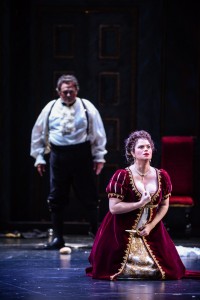Tosca: A Captivating Performance

Though Puccini’s Tosca, an opera based on Victorien Sardou’s 1887 play, La Tosca, was first performed at the Teatro Costanzi in Rome on 14 January 1900, it holds a timeless relevance. The opera lays bare themes of abuse of power, questions religious institution, and effectively explores the reaches human passion. Here, under the stage direction of Guy Montavon and with a powerful operatic trio at its helm, Tosca is highly dramatic, visually stunning, and a thoroughly beautiful showcase of this classic opera. It is playing at the NAC until September 13.
Tosca is set in Rome, against the turbulent political backdrop of the French Revolutionary Wars. Opera singer Tosca and her lover Mario Cavaradossi, an artist, are caught in the web of the cruel chief of secret police, Baron Scarpia. Driven by insatiable lust and want of power, Scarpia locks his sights on Tosca and begins a ruthless game of manipulation.
Soprano Michele Capalbo represents the fiery and passionate Tosca, while tenor David Pomeroy is Cavaradossi, her romantic counterpart. The two actors happen to have previously played Tosca and Cavaradossi together during the Vancouver Opera’s 2013 season. Their history together in these roles is a real gift to Ottawa audiences. Simply put: You will be swept off your feet. Their voices together are glorious and carry tremendous impact, while their dynamic onstage will make your heart flutter. Paired with strong staging by director Guy Montavon, “powerful” is an understatement. Capalbo and Pomeroy strike a fine balance between an affected, operatic style of acting, while nonetheless developing a sense of real intimacy.
Baron Scarpia, played by baritone Todd Thomas, contrasts the two lovers with his lustful passion for power and control. Every bit the villain, Scarpia would run his hands slowly down his torso and loins in a gesture that is lascivious and loathsome. The gesture is repeated throughout the play to indicate his crude motivations, just as Scarpia’s leitmotif—the moody series of chords that open the opera—is revisited throughout. Thomas’ unsubtle, dramatic use of gesture and robust voice work in perfect harmony with Puccini’s powerful leitmotifs to a really affective result. In short: If Tosca didn’t stab him, someone else just might.
It is only in the third act that the staging drifts too far toward affected acting. When Tosca meets Cavaradossi to announce his life will be spared and that they will be able to spend their lives together, the actors take marks across the stage from one another for the majority of the scene. While director Montavon achieves visually pleasing staging, it’s at the expense of the story onstage. Cavaradossi has just lamented that he would never see his beloved again, and yet, when she appears, they only embrace briefly before they separate to the most distant parts of the stage from one another. The scene is celebratory in nature as the lovers re-affirm their devotion to one another, yet, the passion that the audience hears in their duet is incongruous with the staging.
The scene design, by David Gano, features three grand depictions of architecture in Rome. In particular, the set design during the third act is really captivating: A forced perspective depiction of the rooftop of Castel Sant’Angelo, overlooking St. Peter’s Basilica (a structure that represents traditionalism and the looming religious influence in Rome) far in the background, becomes the scene where Tosca and Cavaradossi meet their final undoing. It is not only visually stunning, but a great tribute to the Italian historical origin of forced perspective scenery. The theme of religious corruption is one of the pillars on which this opera rests—from the Sacristan’s animosity toward Cavaradossi to the composition of the Te Deum itself—and Opera Lyra’s production leverages this important historical reference throughout. Just as Puccini has woven religious themes into the text and music, so too are these themes present in the scene design. The audience gains laser-sharp clarity of the role of the church in Scarpia’s game of manipulation, and the role of the church therein.
A masterful use of lighting heightens the religious atmosphere of the opera, and compliments the setting. In the first act, soft lighting streams into the cathedral as if through high windows, while a shift of lighting in the second act emphasizes Tosca’s dark turn away from religious devotion. Driven to madness under Scarpia’s manipulation, Tosca transforms into a deliverer of justice and retribution. The lighting shifts so that only her silhouette is visible, while Scarpia lies dead downstage center. The candlelit effect does true justice to the dark ending of a dark act.
Despite dramatic irony, audiences will nonetheless be tortured by Tosca’s naive hope driven by passion, and Cavaradossi’s blind trust in the woman he so faithfully admires. The final scene on the rooftop of Castel Sant’Angelo is tense and highly dramatic. Though we know how it will end, it is a mark of the great acting and strong staging that we are on the edges of our seats until the very end.
Tosca, presented by Opera Lyra, is an example of a wonderful collaboration of artists. It is compelling, enveloping, and will certainly be a memorable experience. From details in the set, staging, and costume, to captivating dynamics between characters and sweeping turns in plot, Tosca will defy your expectations of melodrama.
Visit www.OperaLyra.ca for full details.
Cast
Floria Tosca – Michele Capalbo
Mario Cavaradossi – David Pomeroy
Baron Scarpia – Todd Thomas
Angelotti/Jailer – Giles Tomkins
Production
Conductor – Tyrone Paterson
Stage Director – Guy Montavon
Chorus Master – Laurence Ewashko
Children’s Chorus Leader – Jamie Loback
Repetiteur – Judy Ginsburg
Stage Manager – Kelly Luft